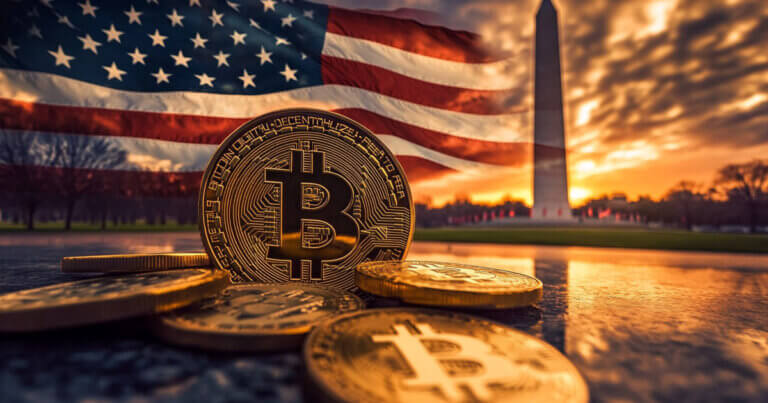Introduction
In March 2025, President Donald Trump signed an executive order that created the Strategic Bitcoin Reserve and the United States Digital Asset Stockpile. This action represents a major shift in U.S. financial policy, incorporating Bitcoin (BTC) and certain other cryptocurrencies into the national reserve system. This move signals growing government recognition of blockchain assets and marks a key step toward institutionalizing the Crypto Reserve.
This decision has generated excitement in the market, attracted institutional interest, and provided regulatory clarity. It has led to advantages for particular digital assets and investor groups. But who exactly stands to benefit from this executive order, and which cryptocurrencies are most impacted? Let’s explore.
Key Cryptocurrencies Benefiting from the U.S. Crypto Reserve

The inclusion of cryptocurrencies in the U.S. Digital Asset Stockpile signals government acknowledgment of blockchain assets. The cryptocurrencies set to benefit the most from this development include:
1. Bitcoin (BTC) – The Primary Reserve Asset
- As the main reserve asset, Bitcoin stands to gain the most from this order.
- The U.S. government will likely hold and potentially accumulate more BTC, reducing the overall market supply and increasing demand.
- Institutional investors may be more inclined to increase their Bitcoin holdings now that the U.S. government is backing BTC.
- Bitcoin, often seen as digital gold, strengthens its role as a hedge against inflation and economic uncertainty.
2. Ethereum (ETH) – Institutional Adoption Boost
- Although not the primary reserve asset, Ethereum’s inclusion in the Digital Asset Stockpile adds credibility.
- Ethereum’s ability to support staking and smart contracts makes it an attractive option for DeFi and enterprise adoption.
- U.S. government recognition could lead to increased institutional investments in Ethereum-based projects.
- Ethereum’s Layer 2 solutions might receive more attention as government-backed blockchain projects explore ways to improve scalability.
3. Ripple (XRP) – Regulatory Clarity at Last?
- XRP’s inclusion marks a shift in regulatory views, especially after its past scrutiny by the SEC.
- Ripple’s partnerships with banks and financial institutions could grow under the backing of the U.S. government.
- If XRP is deemed a legitimate reserve asset, it could see faster adoption in global finance.
- Ripple’s technology, particularly for cross-border payments, may experience significant growth with U.S. support.
4. Solana (SOL) – The Layer 1 Alternative
- Solana’s high-speed blockchain and low transaction fees make it a strong contender for government-backed projects.
- The recognition of Solana in the stockpile could attract more funding for Solana-based applications.
- Institutional adoption of Solana may increase as concerns about regulation subside.
- Solana’s NFT and gaming ecosystems may benefit from greater developer confidence and investment from the U.S.
5. Cardano (ADA) – Smart Contracts & Sustainability
- ADA’s energy-efficient proof-of-stake (PoS) mechanism aligns well with government interests in sustainable blockchain technologies.
- As Cardano’s DeFi ecosystem grows, the executive order could encourage more partnerships, both public and private.
- Institutional interest in ADA could rise due to clearer regulatory guidelines.
- Cardano’s focus on research-driven development resonates with U.S. priorities for sustainable blockchain innovations.
Who Benefits from the U.S. Crypto Reserve?

In addition to specific cryptocurrencies, several groups of investors and industries stand to gain from this executive order:
1. Institutional Investors & Hedge Funds
- With government recognition, hedge funds and financial institutions may increase their investments in cryptocurrencies.
- Pension funds, banks, and asset managers can now invest in Bitcoin and altcoins with more regulatory certainty.
- Companies already holding BTC and ETH (like MicroStrategy, Tesla, and BlackRock) could see their portfolios grow.
- Bitcoin ETFs and institutional DeFi products are likely to experience more capital inflows.
2. Crypto Exchanges & Custodians
- Platforms like Coinbase, Binance.US, and Kraken could see higher trading volumes.
- Regulated custodians might experience a surge in demand for secure storage solutions.
- ETF providers offering Bitcoin and Ethereum-based funds could attract more institutional clients.
- Stablecoin issuers may benefit from increased government support as regulatory policies evolve.
3. Blockchain Developers & DeFi Projects
- The executive order’s regulatory clarity supports innovation within the blockchain and DeFi sectors.
- Developers working on Ethereum, Solana, and Cardano may attract more venture capital funding.
- Government-backed blockchain projects could emerge, encouraging broader public sector adoption.
- Smart contract developers focused on compliance-based financial applications could find new funding opportunities.
4. Retail Investors & Early Adopters
- Long-term crypto holders could benefit from potential price increases as institutional investors enter the market.
- New retail investors may feel more confident entering the space with the U.S. government’s backing.
- As the fear surrounding crypto diminishes, digital assets will become more mainstream.
- Crypto education initiatives are likely to grow, helping retail investors understand the evolving regulatory landscape.
Market Reactions & Future Outlook
The creation of the U.S. Crypto Strategic Reserve has already led to:
- A price rally for Bitcoin, with expectations of new all-time highs.
- Increased adoption of altcoins like Ethereum, XRP, Solana, and Cardano.
- Institutional players reassessing digital asset investments as regulation becomes clearer.
- Traditional financial firms expanding into crypto with more regulatory clarity.
Looking ahead:
- Other nations may follow the U.S. example by establishing their own digital asset reserves.
- Governments might offer incentives for blockchain projects through grants and partnerships.
- Crypto’s integration into the global financial system may speed up, blurring the lines between traditional and digital finance.
- Further legal frameworks could emerge to regulate and support crypto reserves.
Conclusion
The U.S. Crypto Strategic Reserve marks a pivotal moment for the cryptocurrency industry. By officially recognizing Bitcoin and select altcoins, the executive order has elevated digital assets to the status of legitimate financial instruments.
Bitcoin, Ethereum, XRP, Solana, and Cardano are the main beneficiaries, while institutional investors, crypto exchanges, and blockchain developers are set for growth.
As regulations continue to evolve, this move may signal the beginning of widespread crypto adoption globally. Investors and industry participants should closely watch how government-backed crypto strategies unfold in the coming months.






